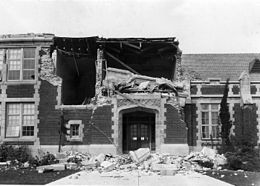 Damage to the John Muir School, Pacific Avenue, Long Beach | |
| UTC time | 1933-03-11 01:54:00 |
|---|---|
| ISC event | 905457 |
| USGS-ANSS | ComCat |
| Local date | March 10, 1933 |
| Local time | 5:54 P.M. PST[1] |
| Magnitude | 6.4 Mw[2] |
| Depth | 10 km (6.2 mi)[2] |
| Epicenter | 33°37′52″N 118°00′00″W / 33.631°N 118.000°W[3] |
| Fault | Newport-Inglewood Fault[4] |
| Type | Strike-slip[5] |
| Areas affected | South Coast (California) United States |
| Total damage | $40 million[1] |
| Max. intensity | MMI VIII (Severe)[1] |
| Peak acceleration | 0.22 g[6] |
| Peak velocity | 20 cm/s (est)[7] |
| Tsunami | No |
| Aftershocks | M5.4 on Oct 2 1933[8] |
| Casualties | 115–120 killed[1][9] |
The 1933 Long Beach earthquake took place on March 10 at 5:54 P.M. PST south of downtown Los Angeles. The epicenter was offshore, southeast of Long Beach, California, on the Newport–Inglewood Fault.[10] The earthquake had a magnitude estimated at 6.4 Mw, and a maximum Mercalli intensity of VIII (Severe). Damage to buildings was widespread throughout Southern California. It resulted in 115 to 120 fatalities and an estimated $40 million worth of property damage, equivalent to $941 million in 2023. The majority of the fatalities resulted from people running out of buildings exposing themselves to the falling debris.
- ^ a b c d Cite error: The named reference
Stoverwas invoked but never defined (see the help page). - ^ a b Cite error: The named reference
ISC-GEMwas invoked but never defined (see the help page). - ^ Cite error: The named reference
USGSwas invoked but never defined (see the help page). - ^ "Southern California Earthquake Data Center: Long Beach Earthquake". Southern California Earthquake Data Center. Retrieved 2021-10-26.
- ^ Cite error: The named reference
Haukssonwas invoked but never defined (see the help page). - ^ "The 1933 Long Beach Earthquake".
- ^ Hough, S. E.; Graves, R. W. (22 June 2020). "Nature:The 1933 Long Beach Earthquake (California, USA) Ground Motions and Rupture Scenario". Scientific Reports. 10 (1): 10017. Bibcode:2020NatSR..1010017H. doi:10.1038/s41598-020-66299-w. PMC 7308333. PMID 32572047.
- ^ Hough, S. E.; Graves, R. W. (22 June 2020). "Nature:The 1933 Long Beach Earthquake (California, USA) Ground Motions and Rupture Scenario". Scientific Reports. 10 (1): 10017. Bibcode:2020NatSR..1010017H. doi:10.1038/s41598-020-66299-w. PMC 7308333. PMID 32572047.
- ^ Cite error: The named reference
NGDCwas invoked but never defined (see the help page). - ^ "Southern California Earthquake Data Center: Long Beach Earthquake". Southern California Earthquake Data Center. Retrieved 2021-05-01.
